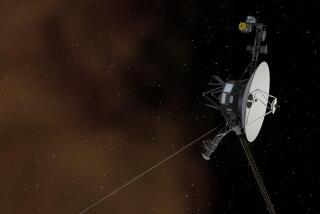Left Solar System 4 Years Ago Today : Pioneer 10 Blazing Space Trail
- Share via
Four years ago today Earth’s emissary to the cosmos completed a sweeping left turn the other side of Pluto and became the first man-made object to leave the solar system.
Pioneer 10, carrying a plaque designed to tell any other intelligent beings what humans are like and where they live, is still beaming back scientific data 10 hours a day as it plunges through space 4 billion miles from Earth.
The 570-pound spacecraft, built by TRW Inc. of Redondo Beach and managed by NASA’s Ames Research Center in Mountain View, Calif., was launched on March 2, 1972, and is now so far away that it takes 5 hours and 49 minutes for its radio transmissions to reach Earth.
“It has not reported any unexpected phenomena outside the solar system,” a TRW spokesman said. That is not surprising to scientists, since the small craft has now entered the relative void of space.
Silenced by Distance
The craft is expected to continue transmitting data back to Earth for several more years, and then its radio will be silenced by distance and time as Pioneer speeds toward whatever destination fate has assigned.
Perhaps millions of years down that lonely road, it will be intercepted by creatures who have mastered their corner of space. Aboard the craft, they will find a 6-by-9-inch gold-anodized plaque designed to tell them that we are here.
The plaque is encoded with symbols that its creators believe should be universal--such fundamental factors as the composition of the hydrogen atom, the most common element in the universe, and a yardstick that all creatures should understand, the wavelength of radio waves.
That should allow the finders to determine the size of the plaque’s nude male and female figures, once condemned by some earthlings who found their lack of clothing offensive.
Reveals Location
The plaque reveals the location of Earth by its direction from a series of pulsars, stars that emit bursts of radio waves. When pulsars were first discovered, scientists thought the peculiar transmissions might be signals from other forms of life, but researchers soon swept away that theory when they determined that the radio waves are produced by a rapidly spinning neutron star.
Nonetheless, pulsars have probably fascinated any other intelligent life, just as they have scientists on Earth, and their positions should be well enough known to serve as a road map to Earth, depicted as the third planet out from the sun.




